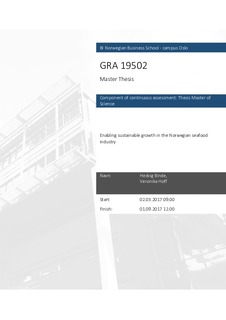Enabling sustainable growth in the Norwegian seafood industry
Master thesis

View/
Date
2017Metadata
Show full item recordCollections
- Master of Science [1621]
Abstract
This master thesis focuses on the seafood cluster of Western Norway, and
analyzes how the cluster can resolve the environmental challenges in the industry
through innovations. The industry is currently facing a turning point, where
further growth can be feasible only if the environmental challenges in the
industry, namely sea lice, fish escapes and area utilization, are resolved. The
government has introduced means, in the form of development licenses, to
incentivize the industry to realize new technological innovations. This created an
exciting impetus for empirical application of theories – clustering, innovation and
sustainability. The study contributes by exploring the intersections between the
different theories.
The data collected for this thesis contain semi-structured interviews carried
out with cluster member representatives that were knowledgeable about the
industry and the innovations emerging from the cluster. In addition, a
comprehensive selection of secondary data was collected to support the primary
data. The authors applied the Emerald Model (Reve & Sasson, 2012) for the
purpose of analyzing the cluster, and consider its completeness and knowledge
interactions in relation to its capacity to innovate. Further, specific selected
innovation projects were analyzed in terms of their nature and impact on the
industry. Moreover, Porter and Linde’s (1995) theory of a properly crafted
environmental regulations were applied in the analysis of these projects, and their
potential to resolve the sustainable issues of the industry. The innovation projects
subject to the case study were “The Egg” (Marine Harvest and Hauge Aqua) and
“Ocean Farm 1” (SalMar).
The research found that the chosen cluster obtains a complete value chain
and to an extent strong knowledge relations and interactions, and hence possesses
a high capacity to innovate. The authors regarded the innovations “The Egg” and
“Ocean Farm 1” as sustaining radical innovations that may eliminate the
environmental challenges, if successful. However, the realization of such projects
hinges on the granting of development licenses, and thus the authors question
whether the rest of the industry is able to adopt similar solutions. In addition, the
authors believe that a technical solution is unlikely to solve these issues alone, but
could prove successful in combination with a biological solution.
Description
Masteroppgave(MSc) in Master of Business, Handelshøyskolen BI, 2017